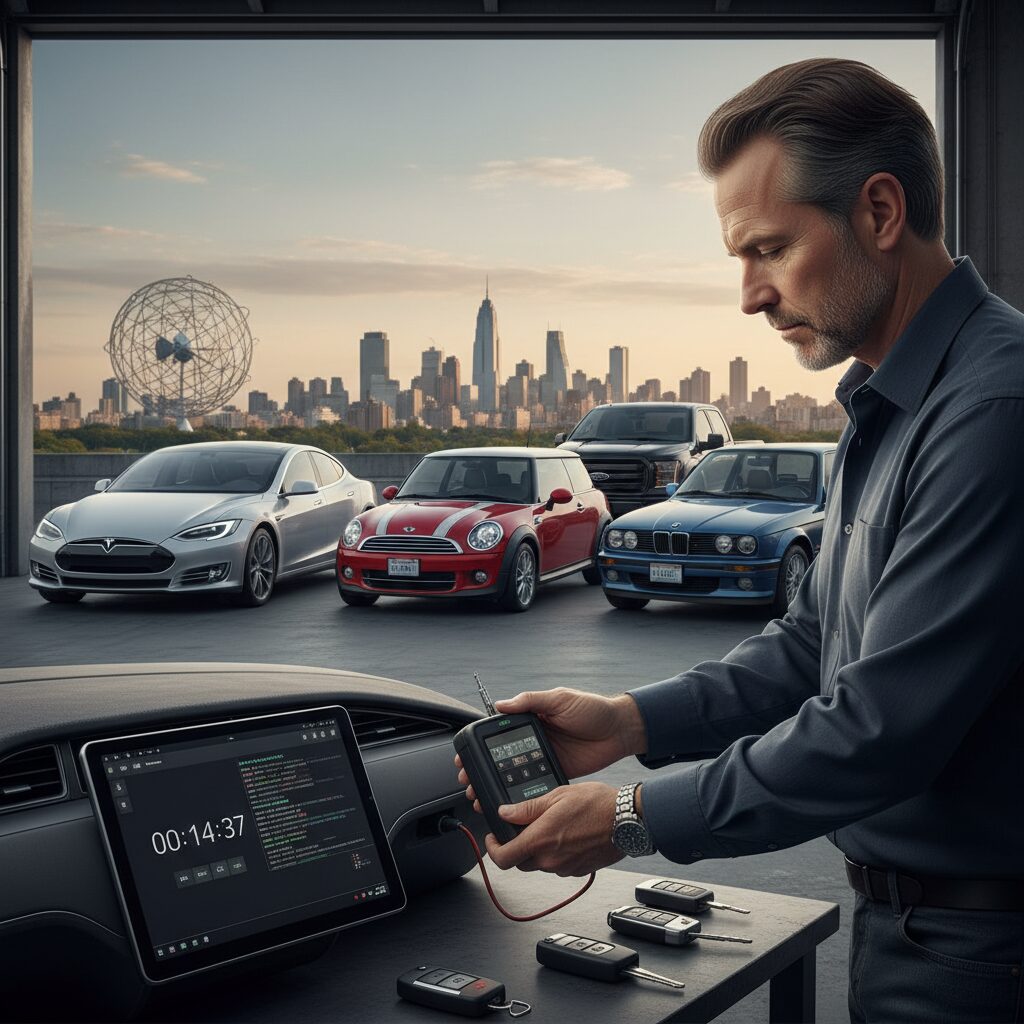How long does key programming take in Queens is the question most drivers ask the moment schedules are already off-track—and 24 Hour Locksmith Queens was built to answer it quickly, on-site, and without towing or multi-day dealer delays.
The answer depends on the key family (transponder, remote-head/flip, or proximity smart fob), the vehicle’s security generation, whether there’s a working key (duplicate) or an all-keys-lost (AKL) situation, whether VIN/code cutting is available, and on-site conditions like garage access and battery voltage.
Across Queens neighborhoods—Jamaica, Flushing, Forest Hills, Astoria, Bayside, Elmhurst, Long Island City, Corona, College Point, and Sunnyside—these variables can shift the timing from under half an hour to about an hour, with rare security-heavy platforms pushing longer.

Key Takeaways
- Transponder duplicates: 20–40 minutes
- Remote-head keys: 30–60 minutes
- Proximity smart fobs: 45–90 minutes
- Timing increases for AKL, encrypted/brand-restricted systems, re-keyed locks, and garages with weak signals.
- 24 Hour Automotive Locksmith Queens keeps timing short by cutting to code, stabilizing voltage, using platform-correct programmers, and validating proximity zones before sign-off.
How Long Does Key Programming Take in Queens: The Quick, Honest Answer
In straightforward curbside conditions:
- Transponder duplicate: 20–40 minutes
- Remote-head/flip key: 30–60 minutes
- Proximity push-to-start fob: 45–90 minutes
- All-keys-lost (AKL) or luxury security: More time needed
Key Family Changes Everything
Transponder (chip) blades
- Fastest when VIN codes match
- Typically 20–40 minutes for duplicates
- Re-keyed cylinders add a quick decode step
Remote-head and flip keys
- Require immobilizer pairing plus remote button sync
- 30–60 minutes including door-lock, trunk, and panic testing
Proximity push-to-start fobs
- Need secure authorization and proximity zone validation
- 45–90 minutes is normal depending on brand and platform
Duplicate vs All Keys Lost (AKL)
- With a working key: Faster add-key routines keep time lean
- All keys lost: Extra steps like PIN retrieval and tokens extend programming
💡 Tip: Approve a same-visit spare while the programmer is connected—it saves time and money later.
VIN Code Cutting vs Decoding
- Original locks: VIN codes allow an immediate perfect cut
- Re-keyed locks: Require decoding, adding minutes but preventing rough-turn issues
Voltage, Alarms, and Modules
- Low voltage = failed enrollments and wasted time → pros use boosters
- Armed alarms and deadlocks enforce sequences → respecting them keeps timing predictable
Queens Logistics: Neighborhood Influences
- Jamaica: Share precise cross-streets/plaza sections → saves staging time
- Flushing: Underground garages weaken signals → stage near entrances
- Forest Hills: Correct curb side matters to avoid routing delays
- Astoria: Tight nightlife lanes → exact staging protects programming window
- Bayside: Driveways/lots ideal for quick spares
- Elmhurst: Mall garages need exact level/section → reduces variability
- Long Island City: Share height limits to avoid van swaps
- Corona: Night curb jobs need brighter staging and accuracy
- College Point: Industrial lots provide space for cutting and testing
- Sunnyside: Exact block/side avoids loops and wasted minutes
Where the Minutes Go
- Verification: 3–10 min
- Cutting/decoding: 5–20 min
- Power & staging: 3–10 min
- Enrollment: 10–45+ min
- Validation tests: 5–15 min
- Same-visit spare: 5–20 min
Push-to-Start vs Transponder
- Transponders: Finish after cut + immobilizer add
- Proximity fobs: Require cabin-zone validation, start button tests → longer
Customer-Supplied Parts
- Wrong chipset or frequency = failed pairing → wasted time
- Always match exact part number and frequency
DIY vs Professional
- Older cars may allow DIY, but most modern systems require pro tools and voltage stability
- DIY failures can lock modules and trigger wait timers
- Professionals finish faster and more reliably
Common Issues That Waste Time
- Rough/incorrect key cut
- Weak coin-cell battery in new remote
- Misaligned fob shell
- Armed alarms or deadlocks
How to Keep Programming Short
- Share VIN, year/make/model/trim, and re-key status
- Give precise location details (cross-streets, garage level, height limits)
- Mention battery/alarm conditions
- Approve a same-visit spare
- If supplying a fob, confirm chipset, part number, and frequency
Why Choose 24 Hour Locksmith Queens
- On-site finish, no towing → faster results
- Licensed & verification-first → secure and professional
- Accurate cuts & decodes → no wasted time
- Stable power = stable results
- Full validation before sign-off
- Same-visit spares + lost/stolen removal
- Neighborhood-smart routing & honest ETAs across Queens
Queens FAQs
Do I have to tow to the dealer?
No—most platforms can be programmed on-site.
Can you program a fob with no working key?
Yes, but AKL adds extra secure steps and time.
How long do proximity fobs take compared with transponders?
Proximity: 45–90 min vs 20–40 min for many transponders.
Will a weak car battery slow things down?
Yes—pros stabilize voltage to avoid failed enrollments.
Do aftermarket fobs add time?
No, if matched by exact specs; mismatches waste time.
Strong Call-to-Action
If the goal is to keep car key programming short and predictable, bring the solution to the curb with 24 Hour Locksmith Queens—code/laser cutting, secure enrollment, stable power, full validation, and a same-visit spare so tomorrow stays easy.
📞 Call 24 Hour Locksmith Queens now: (646) 543-7472
